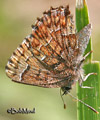Native Plants
Search for native plants by scientific name, common name or family. If you are not sure what you are looking for, try the Combination Search or our Recommended Species lists.
Pinus virginiana
Pinus virginiana Mill.
Virginia Pine, Jersey Pine, Scrub Pine
Pinaceae (Pine Family)
Synonym(s):
USDA Symbol: PIVI2
USDA Native Status: L48 (N), CAN (I)
Virginia pine is a straggling, scrubby evergreen, usually 15-40 ft. tall, becoming flat-topped with age. Outstretched limbs spring irregularly from the reddish-brown trunk. Cones are sharp to the touch due to prickly-like appendages. Short-needled tree with open, broad, irregular crown of long spreading branches; often a shrub.
Used principally for pulpwood and lumber, it is hardier than most pines and suitable for planting in poor dry sites. Common in old fields as a pioneer after grasses on hills of the Piedmont, growing rapidly and forming thickets. Later this pine is replaced by taller, more valuable hardwoods.
Plant Characteristics
Duration: PerennialHabit: Tree
Leaf Retention: Evergreen
Leaf Arrangement: Fascicled
Leaf Complexity: Simple
Leaf Shape: Linear
Breeding System: Flowers Unisexual , Monoecious
Fruit Type: Cone
Size Notes: Up to about 55 feet tall, often shorter.
Leaf: Green
Fruit: Reddish brown
Bloom Information
Bloom Color: Yellow , BrownBloom Time: Apr
Bloom Notes: Flowers inconspicuous. Pollen cones reddish brown to yellow.
Distribution
USA: AL , DC , DE , GA , IN , KY , MD , MO , MS , NC , NJ , NY , OH , PA , SC , TN , VA , WVNative Distribution: Long Island to PA & s. IN, s. to GA & n.e. MS
Native Habitat: Areas of poor, light soil in mountains and old fields
Growing Conditions
Water Use: LowLight Requirement: Sun
Soil Moisture: Moist
CaCO3 Tolerance: Low
Soil Description: Poor, well-drained soils.
Conditions Comments: The species is valuable as cover for dry, barren sites. It dislikes shallow, chalky soils and is not tolerant of over-topping by other trees.
Benefit
Use Wildlife: Seeds are an important wildlife food.Attracts: Birds
Butterflies and Moths of North America (BAMONA)
|
Eastern Pine Elfin (Callophrys niphon)  Larval Host |
Propagation
Description: Propagate by seed.Seed Treatment: Pretreatment is usually not necessary, but germination of pine seeds exhibiting dormancy can be hastened by cold stratification.
Commercially Avail: yes
From the National Organizations Directory
According to the species list provided by Affiliate Organizations, this plant is on display at the following locations:Delaware Nature Society - Hockessin, DE
Georgia Native Plant Society - Atlanta, GA
Mt. Cuba Center - Hockessin, DE
Bibliography
Bibref 1186 - Field Guide to Moths of Eastern North America (2005) Covell, C.V., Jr.Bibref 1185 - Field Guide to Western Butterflies (Peterson Field Guides) (1999) Opler, P.A. and A.B. Wright
Bibref 1620 - Gardening with Native Plants of the South (Reprint Edition) (2009) Wasowski, S. with A. Wasowski
Search More Titles in Bibliography
Web Reference
Webref 3 - Flora of North America (2014) Missouri Botanical Garden, St. Louis, MO & Harvard University Herbaria, Cambridge, MA.Additional resources
USDA: Find Pinus virginiana in USDA PlantsFNA: Find Pinus virginiana in the Flora of North America (if available)
Google: Search Google for Pinus virginiana
Metadata
Record Modified: 2022-10-07Research By: TWC Staff